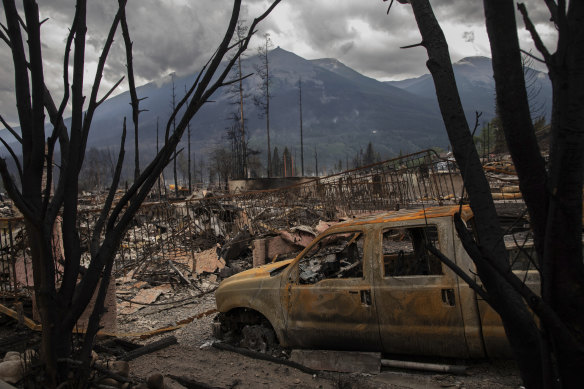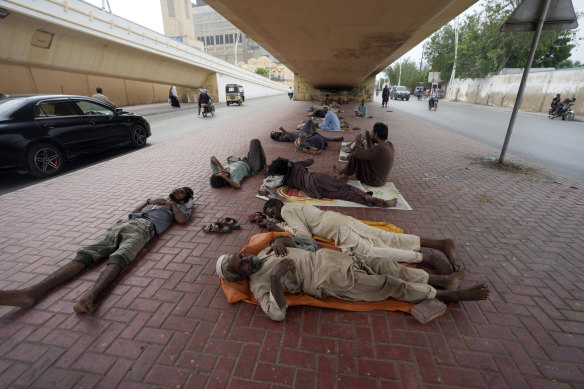Heat records are toppling in the northern hemisphere. What does it mean for Australia’s summer?
Temperatures have topped 50 degrees in 10 countries, from Iran to the United States, in the past year, as extreme heat grips the northern hemisphere for the second summer in a row.
But Australia seems unlikely to experience the same fate, with the chance of a La Nina, associated with cool and wet weather, being declared by spring.

Tourists shade themselves with umbrellas in Macedonia in August.Credit: Bloomberg
The World Meteorological Organisation reports local temperature records were broken in nations including China and Spain in July, and heatwave conditions have persisted into August in much of Europe, North Africa, the Middle East, Asia and North America.
Over the northern summer, huge wildfires have ravaged the west coast of Canada and the United States, and heatwaves closed schools for 80 million children in Asia and Africa. Scorching weather forced Greece to shut the Acropolis and disrupted the Olympics in Paris, and 1300 pilgrims died from heat on the Hajj in Saudi Arabia.
United Nations Secretary-General Antonio Guterres has observed a rapid rise in the scale, frequency and duration of extreme-heat events.
“Billions of people are facing an extreme heat epidemic – wilting under increasingly deadly heatwaves, with temperatures topping 50 degrees Celsius around the world,” he said in a speech in late July.
Globally, July 2024 was one of the hottest months in history. US data says it was the warmest July in its 175-year record, while European figures put it just behind July 2023. Last month also featured the two hottest individual days on record, with the global average peaking at 17.16 degrees on July 22.
The World Meteorological Organisation has mapped temperatures above 50 degrees ringing the globe from North America to North Africa, the Middle East and Asia over the past year.
The global record is 56.7 degrees in Death Valley, California, recorded in 1913, but any reading above 50 is rare.
Australia has officially recorded temperatures of 50.7 degrees in Onslow, Western Australia, in 2022 and Oodnadatta, South Australia, in 1960, and 50.1 in Wilcannia, NSW, in 1939.

A devastated residential neighbourhood in Jasper, in the Canadian Rocky Mountains.Credit: AP
The milestone not yet been reached in continental Europe, where the record set in 2021 was 48.8 degrees in Sicily, Italy.
British climate activist Roger Hallam, founder of Extinction Rebellion, said on social media platform X last week that cases of extreme heat were the critical measure, while average figures were “completely irrelevant”.
“The horror is in how often the long tail happens; how often a place hits the ‘all humans die in one day’ point.”
The World Meteorological Organisation and the World Health Organisation estimate about 489,000 heat-related deaths occur each year, 45 per cent in Asia and 36 per cent in Europe.

A girl floating in the River Stour in Britain in August.Credit: Dan Kitwood / Getty Images
Professor Sebastian Pfautsch from Western Sydney University said the true number was probably much higher because most developing countries were unable to count heat mortality.
In 2022, 62,000 people died from heatwaves in Europe, according to a peer-reviewed article in Nature Medicine. In 2023, Nature estimated it was 48,000.
“I’m watching in horror because … it indicates that we’re completely under prepared,” Pfautsch said. “How are we doing [in Australia]? Not very well, we’re about 10 to 15 years behind in those preparations that other countries have started.”
In western Sydney, where 2.6 million people live, some predictions say there could be more than 90 consecutive days above 35 degrees in summer by 2060.

Labourers sleep under a bridge on a hot day in Karachi, Pakistan in July.Credit: AP
The World Health Organisation says any temperature above 28.9 degrees increases mortality rates. However, Pfautsch said relative humidity plays a role, since sweating does not effectively cool the body when it’s humid.
A 2010 study in the peer-reviewed PNAS science journal suggested that a human could not survive for more than six hours at a “wet bulb temperature” – the reading when a wet cloth is over the bulb of a thermometer – of 35 degrees.
“We know that 99 per cent relative humidity and 35 degrees … is a lethal temperature, but 45 degrees and 10 per cent relative humidity is absolutely survivable,” Pfautsch said. “That’s why humid heatwaves, which are increasing around … the tropics, are so dangerous.”
Pfautsch said hospitalisations also spiked when overnight temperatures were high for three or more nights because people could not escape the heat.
Despite the long-term risk, Australia is not likely to have a hot, dry summer this year.
The Bureau of Meteorology reports an equal chance of a La Nina or a neutral climate by the end of winter. A La Nina summer – like the one which brought widespread flooding to Australia’s east coast in 2021-22 – is associated with cooler, wetter weather.
Professor Matthew England, a climate scientist at the University of NSW, said other models suggest a La Nina is more likely.
“It’s a respite from one extreme, being heatwaves and bushfires, but those flooding rains can be very damaging,” England said.
Get to the heart of what’s happening with climate change and the environment. Sign up for our fortnightly Environment newsletter.